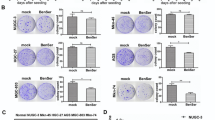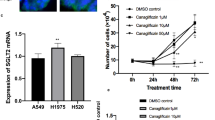Abstract
Sodium-glucose transporter 2 (SGLT2) inhibitors are antidiabetic drugs affecting SGLT2. Recent studies have shown various cancers expressing SGLT2, and SGLT2 inhibitors attenuating tumor proliferation. We evaluated the antitumor activities of canagliflozin, a SGLT2 inhibitor, on glioblastoma (GBM). Three GBM cell lines, U251MG (human), U87MG (human), and GL261 (murine), were used. We assessed the expression of SGLT2 of GBM through immunoblotting, specimen-use, cell viability assays, and glucose uptake assay with canagliflozin. Then, we assessed phosphorylation of AMP-activated protein kinase (AMPK), p70 S6 kinase, and S6 ribosomal protein by immunoblotting. Concentrations of 5, 10, 20, and 40 μM canagliflozin were used in these tests. We also evaluated cell viability and immunoblotting using U251MG with siRNA knockdown of SGLT2. Furthermore, we divided the mice into vehicle group and canagliflozin group. The canagliflozin group was administrated with 100 mg/kg of canagliflozin orally for 10 days starting from the third days post-GBM transplant. The brains were removed and the tumor volume was evaluated using sections. SGLT2 was expressed in GBM cell and GBM allograft mouse. Canagliflozin administration at 40 μM significantly inhibited cell proliferation and glucose uptake into the cell. Additionally, canagliflozin at 40 μM significantly increased the phosphorylation of AMPK and suppressed that of p70 S6 kinase and S6 ribosomal protein. Similar results of cell viability assays and immunoblotting were obtained using siRNA SGLT2. Furthermore, although less effective than in vitro, the canagliflozin group significantly suppressed tumor growth in GBM-transplanted mice. This suggests that canagliflozin can be used as a potential treatment for GBM.







Similar content being viewed by others
Data and Material Availability
The datasets during the current study are available from the corresponding author on reasonable request.
References
Arvanitis CD, Ferraro GB, Jain RK (2020) The blood-brain barrier and blood-tumour barrier in brain tumours and metastases. Nat Rev Cancer 20:26–41. https://doi.org/10.1038/s41568-019-0205-x
Avci NG, Ebrahimzadeh-Pustchi S, Akay YM et al (2020) NF-κB inhibitor with temozolomide results in significant apoptosis in glioblastoma via the NF-κB(p65) and actin cytoskeleton regulatory pathways. Sci Rep 10:13352. https://doi.org/10.1038/s41598-020-70392-5
Cantó C, Auwerx J (2010) AMP-activated protein kinase and its downstream transcriptional pathways. Cell Mol Life Sci 67:3407–3423. https://doi.org/10.1007/s00018-010-0454-z
Cuddapah VA, Robel S, Watkins S, Sontheimer H (2014) A neurocentric perspective on glioma invasion. Nat Rev Neurosci 15:455–465. https://doi.org/10.1038/nrn3765
Faubert B, Boily G, Izreig S et al (2013) AMPK is a negative regulator of the Warburg effect and suppresses tumor growth in vivo. Cell Metab 17:113–124. https://doi.org/10.1016/j.cmet.2012.12.001
Fujita Y, Inagaki N (2014) Renal sodium glucose cotransporter 2 inhibitors as a novel therapeutic approach to treatment of type 2 diabetes: clinical data and mechanism of action. J Diabetes Investig 5:265–275. https://doi.org/10.1111/jdi.12214
Ganapathy V, Thangaraju M, Prasad PD (2009) Nutrient transporters in cancer: relevance to Warburg hypothesis and beyond. Pharmacol Ther 121:29–40. https://doi.org/10.1016/j.pharmthera.2008.09.005
Gatenby RA, Gillies RJ (2004) Why do cancers have high aerobic glycolysis? Nat Rev Cancer 4:891–899. https://doi.org/10.1038/nrc1478
Gilbert MR, Wang M, Aldape KD et al (2013) Dose-dense temozolomide for newly diagnosed glioblastoma: a randomized phase III clinical trial. J Clin Oncol 31:4085–4091. https://doi.org/10.1200/JCO.2013.49.6968
Gilbert MR, Dignam JJ, Armstrong TS et al (2014) A randomized trial of bevacizumab for newly diagnosed glioblastoma. N Engl J Med 370:699–708. https://doi.org/10.1056/NEJMoa1308573
Gittleman H, Lim D, Kattan MW et al (2017) An independently validated nomogram for individualized estimation of survival among patients with newly diagnosed glioblastoma: NRG Oncology RTOG 0525 and 0825. Neuro Oncol 19:669–677. https://doi.org/10.1093/neuonc/now208
Guda MR, Labak CM, Omar SI et al (2019) GLUT1 and TUBB4 in glioblastoma could be efficacious targets. Cancers (basel) 11:1308. https://doi.org/10.3390/cancers11091308
Gwinn DM, Shackelford DB, Egan DF et al (2008) AMPK phosphorylation of raptor mediates a metabolic checkpoint. Mol Cell 30:214–226. https://doi.org/10.1016/j.molcel.2008.03.003
Hawley SA, Ford RJ, Smith BK et al (2016) The Na+/glucose cotransporter inhibitor canagliflozin activates AMPK by inhibiting mitochondrial function and increasing cellular AMP levels. Diabetes 65:2784–2794. https://doi.org/10.2337/db16-0058
Hung MH, Chen YL, Chen LJ et al (2019) Canagliflozin inhibits growth of hepatocellular carcinoma via blocking glucose-influx-induced β-catenin activation. Cell Death Dis 10:420. https://doi.org/10.1038/s41419-019-1646-6
Inagaki N, Kondo K, Yoshinari T et al (2013) Efficacy and safety of canagliflozin in Japanese patients with type 2 diabetes: a randomized, double-blind, placebo-controlled, 12-week study. Diabetes Obes Metab 15:1136–1145. https://doi.org/10.1111/dom.12149
Jelluma N, Yang X, Stokoe D et al (2006) Glucose withdrawal induces oxidative stress followed by apoptosis in glioblastoma cells but not in normal human astrocytes. Mol Cancer Res 4:319–330. https://doi.org/10.1158/1541-7786.MCR-05-0061
Jojima T, Wakamatsu S, Kase M et al (2019) The SGLT2 inhibitor canagliflozin prevents carcinogenesis in a mouse model of diabetes and non-alcoholic steatohepatitis-related hepatocarcinogenesis: association with SGLT2 expression in hepatocellular carcinoma. Int J Mol Sci 20:5237. https://doi.org/10.3390/ijms20205237
Kaji K, Nishimura N, Seki K et al (2018) Sodium glucose cotransporter 2 inhibitor canagliflozin attenuates liver cancer cell growth and angiogenic activity by inhibiting glucose uptake. Int J Cancer 142:1712–1722. https://doi.org/10.1002/ijc.31193
Kepe V, Scafoglio C, Liu J et al (2018) Positron emission tomography of sodium glucose cotransport activity in high grade astrocytomas. J Neurooncol 138:557–569. https://doi.org/10.1007/s11060-018-2823-7
Komatsu S, Nomiyama T, Numata T et al (2020) SGLT2 inhibitor ipragliflozin attenuates breast cancer cell proliferation. Endocr J 67:99–106. https://doi.org/10.1507/endocrj.EJ19-0428
Liu GY, Sabatini DM (2020) mTOR at the nexus of nutrition, growth, ageing and disease. Nat Rev Mol Cell Biol 21:183–203. https://doi.org/10.1038/s41580-019-0199-y
Lu VM, Goyal A, Vaughan LS et al (2018) The impact of hyperglycemia on survival in glioblastoma: a systematic review and meta-analysis. Clin Neurol Neurosurg 170:165–169. https://doi.org/10.1016/j.clineuro.2018.05.020
Macheda ML, Rogers S, Best JD et al (2005) Molecular and cellular regulation of glucose transporter (GLUT) proteins in cancer. J Cell Physiol 202:654–662. https://doi.org/10.1002/jcp.20166
Mihaylova MM, Shaw RJ (2011) The AMPK signalling pathway coordinates cell growth, autophagy and metabolism. Nat Cell Biol 13:1016–1123. https://doi.org/10.1038/ncb2329
Orešković D, Raguž M, Predrijevac N et al (2020) Hemoglobin A1c in patients with glioblastoma - a preliminary study. World Neurosurg 141:e553–e558. https://doi.org/10.1016/j.wneu.2020.05.231
Papadopoli D, Uchenunu O, Palia R et al (2021) Perturbations of cancer cell metabolism by the antidiabetic drug canagliflozin. Neoplasia 23:391–399. https://doi.org/10.1016/j.neo.2021.02.003
Rosenstock J, Aggarwal N, Polidori D et al (2012) Dose-ranging effects of canagliflozin, a sodium-glucose cotransporter 2 inhibitor, as add-on to metformin in subjects with type 2 diabetes. Diabetes Care 35:1232–1238. https://doi.org/10.2337/dc11-1926
Sarkaria JN, Hu LS, Parney IF et al (2018) Is the blood-brain barrier really disrupted in all glioblastomas? A critical assessment of existing clinical data. Neuro Oncol 20:184–191. https://doi.org/10.1093/neuonc/nox175
Saxton RA, Sabatini DM (2017) MTOR signaling in growth, metabolism, and disease. Cell 168:960–976. https://doi.org/10.1016/j.cell.2017.02.004
Scafoglio C, Hirayama BA, Kepe V et al (2015) Functional expression of sodium-glucose transporters in cancer. Proc Natl Acad Sci USA 112:E4111–E4119. https://doi.org/10.1073/pnas.1511698112
Shackelford DB, Shaw RJ (2009) The LKB1-AMPK pathway: metabolism and growth control in tumour suppression. Nat Rev Cancer 9:563–575. https://doi.org/10.1038/nrc2676
Stupp R, Mason WP, van den Bent MJ et al (2005) Radiotherapy plus concomitant and adjuvant temozolomide for glioblastoma. N Engl J Med 352:987–996. https://doi.org/10.1056/NEJMoa043330
Tahara A, Takasu T, Yokono M et al (2016) Characterization and comparison of sodium-glucose cotransporter 2 inhibitors in pharmacokinetics, pharmacodynamics, and pharmacologic effects. J Pharmacol Sci 130:159–169. https://doi.org/10.1016/j.jphs.2016.02.003
Tang H, Dai Q, Shi W et al (2017) SGLT2 inhibitors and risk of cancer in type 2 diabetes: a systematic review and meta-analysis of randomised controlled trials. Diabetologia 60:1862–1872. https://doi.org/10.1007/s00125-017-4370-8
Tsuji S, Nakamura S, Maoka T et al (2020) Antitumour effects of astaxanthin and adonixanthin on glioblastoma. Mar Drugs 18:474. https://doi.org/10.3390/md18090474
Tsuji S, Nakamura S, Yamada T et al (2021) HYBID derived from tumor cells and tumor-associated macrophages contribute to the glioblastoma growth. Brain Res 1764:147490. https://doi.org/10.1016/j.brainres.2021.147490
Villani LA, Smith BK, Marcinko K et al (2016) The diabetes medication canagliflozin reduces cancer cell proliferation by inhibiting mitochondrial complex-I supported respiration. Mol Metab 5:1048–1056. https://doi.org/10.1016/j.molmet.2016.08.014
Watkins S, Robel S, Kimbrough IF et al (2014) Disruption of astrocyte-vascular coupling and the blood-brain barrier by invading glioma cells. Nat Commun 5:4196. https://doi.org/10.1038/ncomms5196
Wright EM, Loo DDF, Hirayama BA (2011) Biology of human sodium glucose transporters. Physiol Rev 91:733–794. https://doi.org/10.1152/physrev.00055.2009
Wright EM (2020) SGLT2 and cancer. Pflugers Arch 472:1407–1414. https://doi.org/10.1007/s00424-020-02448-4
Wu ZP, Gao CW, Wu YG et al (2009) (2009) Chuen Liu Inhibitive effect of artemether on tumor growth and angiogenesis in the rat C6 orthotopic brain gliomas model. Integr Cancer Ther 8(1):88–92. https://doi.org/10.1177/1534735408330714
Xie Z, Wang F, Lin L et al (2020) An SGLT2 inhibitor modulates SHH expression by activating AMPK to inhibit the migration and induce the apoptosis of cervical carcinoma cells. Cancer Lett 495:200–210. https://doi.org/10.1016/j.canlet.2020.09.005
Xiong ZS, Gong SF, Si W et al (2019) Effect of metformin on cell proliferation, apoptosis, migration and invasion in A172 glioma cells and its mechanisms. Mol Med Rep 20:887–894. https://doi.org/10.3892/mmr.2019.10369
Xu D, Zhou Y, Xie X et al (2020) Inhibitory effects of canagliflozin on pancreatic cancer are mediated via the downregulation of glucose transporter-1 and lactate dehydrogenase A. Int J Oncol 57:1223–1233. https://doi.org/10.3892/ijo.2020.5120
Yamada T, Tsuji S, Nakamura S et al (2020) Riluzole enhances the antitumor effects of temozolomide via suppression of MGMT expression in glioblastoma. J Neurosurg 134:701–710. https://doi.org/10.3171/2019.12.JNS192682
Yamamoto L, Yamashita S, Nomiyama T et al (2021) Sodium-glucose cotransporter 2 inhibitor canagliflozin attenuates lung cancer cell proliferation in vitro. Diabetol Int 12:389–398. https://doi.org/10.1007/s13340-021-00494-6
Zhang WB, Wang Z, Shu F et al (2010) Activation of AMP-activated protein kinase by temozolomide contributes to apoptosis in glioblastoma cells via p53 activation and mTORC1 inhibition. J Biol Chem 285:40461–40471. https://doi.org/10.1074/jbc.M110.164046
Zhou J, Zhu J, Yu SJ et al (2020) Sodium-glucose co-transporter-2 (SGLT-2) inhibition reduces glucose uptake to induce breast cancer cell growth arrest through AMPK/ mTOR pathway. Biomed Pharmacother 132:110821. https://doi.org/10.1016/j.biopha.2020.110821
Funding
This research did not receive any specific grant from funding agencies in the public, commercial, or not-for-profit sectors.
Author information
Authors and Affiliations
Contributions
KS contributed to conceptualization, methodology, formal Analysis, investigation, resources, data curation, writing—original draft, and visualization. ST contributed to conceptualization, methodology, investigation, data curation, and visualization. SN contributed to formal analysis, data curation, and supervision. YE contributed to methodology, supervision, formal analysis, and writing—review & editing. NN contributed to supervision and writing—review & editing. MS contributed to formal analysis and supervision. TI contributed to supervision, writing—review & editing, and project administration. HH contributed to conceptualization, writing—review & editing, supervision, and project administration. All authors have read and agreed to the published version of the manuscript.
Corresponding author
Ethics declarations
Conflict of interest
The authors declare that they have no conflict of interest.
Ethical Approval
The Animal Experiment Committee of Gifu Pharmaceutical University (Japan) (Ethic nos. 2020-093) reviewed and approved the animal procedures. Experiments were done according to the ARRIVE (Animal Research: Reporting of In Vivo Experiments) guidelines.
Additional information
Publisher's Note
Springer Nature remains neutral with regard to jurisdictional claims in published maps and institutional affiliations.
Supplementary Information
Below is the link to the electronic supplementary material.
Rights and permissions
About this article
Cite this article
Shoda, K., Tsuji, S., Nakamura, S. et al. Canagliflozin Inhibits Glioblastoma Growth and Proliferation by Activating AMPK. Cell Mol Neurobiol 43, 879–892 (2023). https://doi.org/10.1007/s10571-022-01221-8
Received:
Accepted:
Published:
Issue Date:
DOI: https://doi.org/10.1007/s10571-022-01221-8




